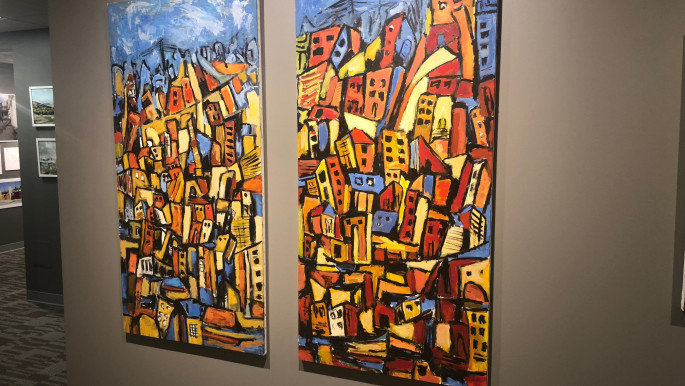Art of resistance: First Palestinian museum in US opens
Now for the first time, Palestinian history and resistance through art has been brought to an American audience.
Palestine Museum US, which opened on Sunday, is a labour of love for businessman Faisal Saleh, who after 40 years of entrepreneurial work, decided to pursue his vision to create a space where "Palestinian artistic achievement is celebrated as part of the rich diversity of people and cultures that make up the United States".
Directing the narrative away from politics to the promotion and preservation of Palestinian identity is one aim of the museum, Saleh told The New Arab.
"There is a great vacuum with respect to Palestinian artistic and cultural media," he said.
|
"For many years Palestinian media efforts have been primarily in the political arena. We would like to change the discourse to the artistic and cultural domain where we believe we can be more effective."
 |
For many diaspora Palestinians, there are gaps in heritage, where families were forced to survive rather than preserve. |  |
The space, in Woodbridge Connecticut, serves as a hub for Palestinian art, literature and culture. Works by globally renowned artists such as Samia Halby, Manal Deeb and Mohamed Saleh Khalil are on display.
Historical artefacts, clothing, literature, archives and new photography also provide a multifaceted tribute to Palestinian art.
|
Born in 1951 in a rented room in El Bireh, Saleh's upbringing was a stark contrast to the life his family enjoyed in the Palestinian village of Salama, where his father - a successful farmer - owned flourishing orange groves and banana trees.
In 1948 the family was among 700,000 Palestinians left homeless by the creation of Israel, known as al-Nakba, or "the Catastrophe".
As a teenager, Saleh grew up against the backdrop of continuing Palestinian resistance to encroaching Israel occupation and stifling repression, Jordanian rule of the West Bank and the 1967 war. Saleh travelled on a full scholarship to the US, graduating in 1974, where he has lived since.
For many diaspora Palestinians, there are gaps in their heritage, where families were forced to survive rather than preserve.
The launch of the museum therefore is "an historic opportunity that entails a heavy responsibility that must be shouldered with great care and determination", said Saleh, who keeps his father's passport with over 30 pages filled with border stamps from 1947 and 1948. Ahmed Saleh, along with other Palestinian citizen ambassadors, traveled to Lebanon, Egypt, Syria and Transjordan, to appeal to Arab governments for assistance in defending Palestinian towns and villages from attacks by Zionist militias.
The unique venue provides a platform, and a viable market, for Palestinian artists who continue to create art under Israeli military occupation, severe economic hardship and restrictions on movement.
Funded by Saleh, with a view to seek donors in the future, the first permanent Palestine museum in the Americas has potential to go global, but for now, Saleh said, Palestine Museum US serves as a "cultural beacon that Palestinians around the world can be proud of".
![Palestine Museum US [Faisel al-Saleh] Palestine Museum US [Faisel al-Saleh]](/sites/default/files/styles/image_345x195/public/media/images/0841DE2D-04A5-463E-82D7-6D280C483584.jpg?h=d1cb525d&itok=bqQ7Vmp0)





